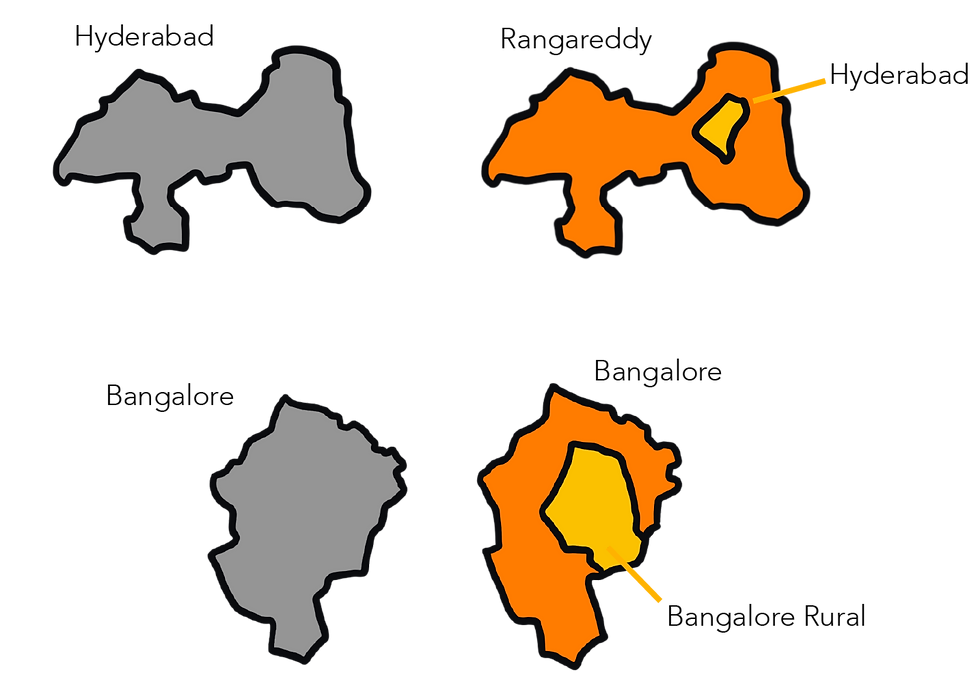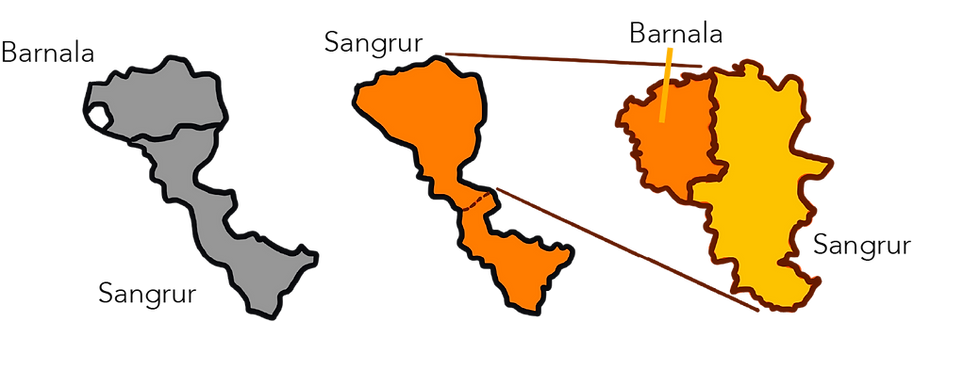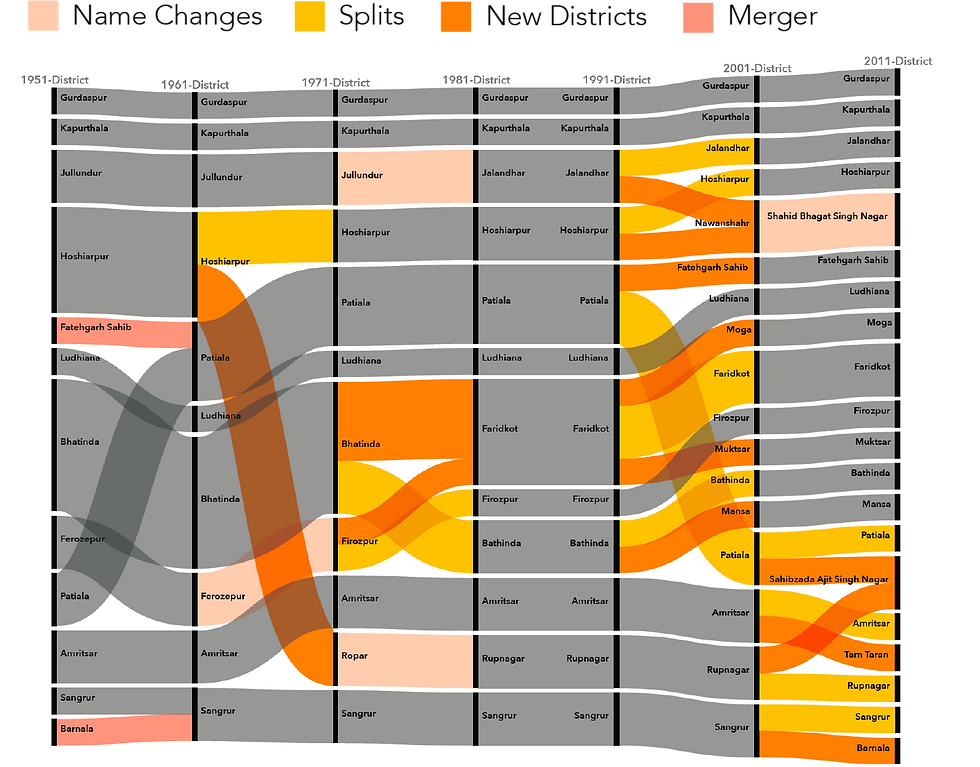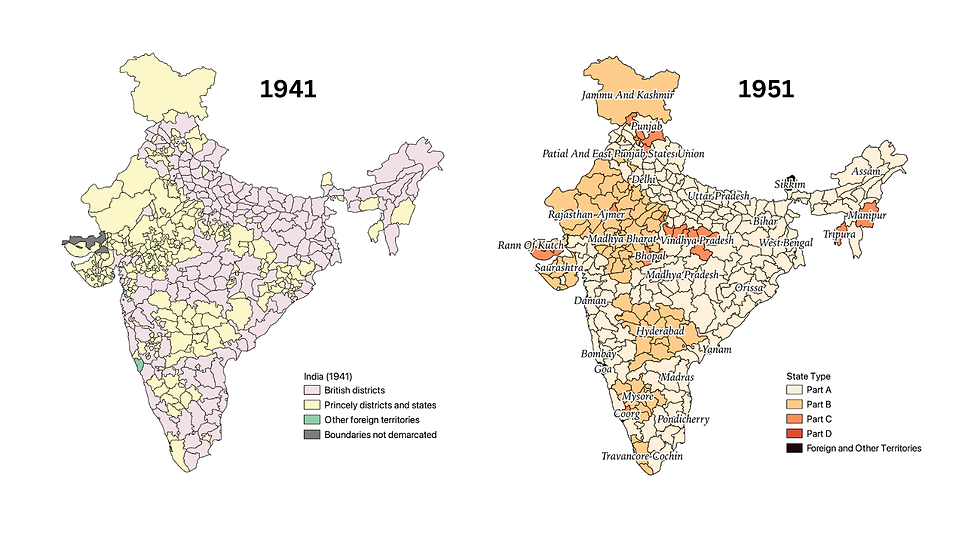1 | How Districts Form & Evolve
- indiastatestories
- Aug 5
- 5 min read
Updated: 3 days ago
The Indian Constitution does not provide specific guidelines for the creation of new districts. The authority to create, alter, or abolish districts lies solely with the respective state governments, with no involvement from the central government. Typically, the creation of a new district is done via issuance of an executive order in the state gazette or by passing a law in the State Assembly. This allows state governments considerable discretion to bifurcate, merge, or redefine district boundaries with a simple notification in the gazette (Singh, 2021).
At the heart of district administration lies the office of the District Officer—alternatively known as the District Collector, District Magistrate, or Deputy Commissioner—an institution that dates back over two hundred years to British colonial rule. Originally created as an instrument of imperial control, the office was designed to centralize authority in the hands of a single official entrusted with revenue collection, maintenance of law and order, judicial and magisterial functions, and general administrative oversight . Despite the transformation of India’s political landscape since Independence, the Collector’s office remains one of the most enduring institutional legacies of colonial governance.
Population, density, and area are common factors that are considered in new district formation. Often, state governments announce the creation of new districts under the guise of “administrative convenience,” but this may conceal other underlying political motives (Kalra & Jolad, 2024).
How new districts are created
We classify district formation in three different ways: Splits that occur when one district breaks up into two or more, and the subset, which is when a new district is carved out of two or more districts, mergers, when two or more districts are joined to create a new one, and name changes, when a district is renamed for political or administrative purposes.
District Splits
When a district is replaced by two or more districts, each of which have a distinguishable part of the area that was within the original district, then the original district is considered to have been split.
Hyderabad(1978): Hyderabad was split, leading to the creation of Rangareddy district.
Bangalore (1986 and 2007): In 1986, Bangalore was split into Bangalore and Bangalore Rural. In 2007, Bangalore Rural was further split to create a new Ramanagara district (renamed as Bengaluru South in 2024).

In 1979, Srikakulam split into Srikakulam and Vizianagaram. Muzaffarpur split into Muzaffarpur , Sitamarhi, and Vaishali in 1972.
The single district Andaman and Nicobar Islands was split into Andaman and Nicobar in 1974.
District Carve outs
When a new district is created from parts of two or three earlier original districts,then the new district is considered to have been carved-out of the original district.
In 1957, Alleppey was carved out from Kottayam and Quilon. Tiruppur district was carved out of parts of Erode and Coimbatore districts in 2009.
Idukki was carved out of Kottayam and Ernakulam in Kerala in 1972.
Tirupati (2022) district was created from parts of Chittoor and Nellore in Andhra Pradesh. Annamayya was carved out of Chittoor and YSR.

Explore the following dashboard to see how districts were split or carved out in various states of India.
District Mergers
At times, districts are also merged to create a new district or to alter an existing district. One of the original districts ceases to exist after the merger. A merger can occur via combining together two existing districts, or by merging one district with parts of another district. No. of districts after will be at least one less than the before. There are very few districts which have been merged post Independence. Barnala, which was part of the PEPSU (Patiala and East Punjab States Union) state in 1951, merged with Sangrur of Punjab by 1961. In 1966, Jind and Narwana tehsils of Sangrur were transferred to newly formed state Haryana. Interestingly it got bifurcated from Sangrur in 2006 forming a new district.

District Renaming
In addition to creation of new districts, districts also evolve through renaming. Name changes are becoming increasingly common these days. Districts are frequently renamed in India for various reasons such as to align linguistic and cultural ethos, tribute state or regional hero, and frequently political ideologies of the ruling party. Noteworthy examples include the renaming of Allahabad to Prayagraj and Osmanabad to Dharashiv.
Explore the following dashboard to see how so many districts have been renamed since Independence.

Implications of District Creation
District creation in India is largely driven by claims of administrative convenience, though evidence often suggests otherwise:
Political Influence: The process of creating new districts is frequently politicized, with governments prioritizing political agendas over public opinion or sound administrative rationale.
Administrative Costs: Former bureaucrats highlight the fiscal and logistical challenges of creating a new district, including the establishment of new administrative offices, separating data, and record management. These processes often strain the nascent district administration.
Impact on Decentralization: While intended to decentralize governance, district creation does not always achieve this goal. Instead, new districts often function as extensions of state administration rather than autonomous entities.
Public Consultation: Draft notifications for district creation occasionally seek public objections, but these are frequently overridden in favor of political or administrative decisions.
References:
Appendix: Types of Name Changes of Districts
The following table shows the name change categories, explaining the rationale or context for each modification, highlighting the interplay of cultural, linguistic, and administrative considerations.
Category | Old Name | New Name | Notes |
Full Change | Madras | Chennai | Represents a complete name change reflecting cultural and linguistic localization. |
Nellore | Sri Potti Sriramulu | Honors a regional freedom fighter, reflecting local historical and cultural pride. | |
Allahabad | Prayagraj | Changed to align with historical and religious significance in Indian culture. | |
Nativization | Trivandrum | Thiruvananthapuram | Localized to the native Malayalam pronunciation, reflecting cultural heritage. |
Belgaum | Belagavi | Reflects the Kannada linguistic form of the name. | |
Calcutta | Kolkata | Adjusted to match the Bengali pronunciation, emphasizing local identity. | |
Prefix | North Kanara | Kanara | Prefix added to distinguish it geographically from South Kanara. |
The Dangs | Dangs | Prefix "The" added to emphasize the unique identity of the region. | |
Prefix and Suffix Added | Muktsar | Sri Muktsar Sahib | Prefix "Sri" and suffix "Sahib" added to reflect religious significance |
Suffix Removed | Tirunelveli Kattabomman | Tirunelveli | This name was changed in 1986 when the district was divided into Nellai-Kattabomman and Chidambaranar districts (now Thoothukudi). The government deciding to name each district after its headquarters town. |
Dindigul Anna | Dindigul | Suffix removed to streamline the district’s name. | |
Suffix Added | Chengalpattu | Chengalpattu MGR | Suffix added to honor a prominent regional leader. |
North Arcot | North Arcot Ambedkar | Added to recognize Dr. B.R. Ambedkar’s contribution to social justice. | |
Suffix Change | Tirap Frontier Tract | Tirap Frontier Division | Changed from "Tract" to "Division" to reflect an administrative reorganization. |
Regional-English Switch | Purbi Singhbhum | East Singhbhum | Transitioned from Hindi to English terminology for better administrative clarity in Jharkhand. |
Pashchimi Singhbhum | West Singhbhum | Similar switch to English for ease of reference in official contexts. | |
Shortening | Siang Frontier Division | Siang | Simplified by removing "Frontier Division" for brevity |
Kameng Frontier | Kameng | Reduced to a single name for ease of recognition. |




Commenti